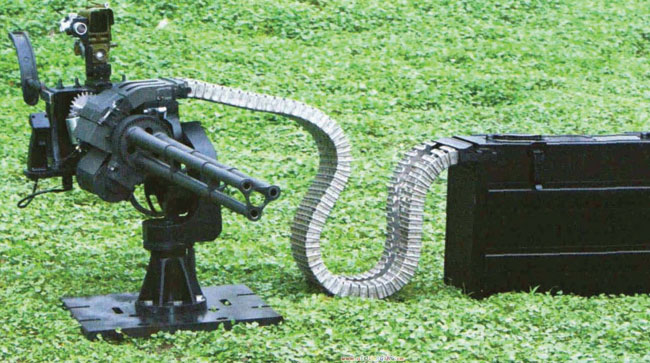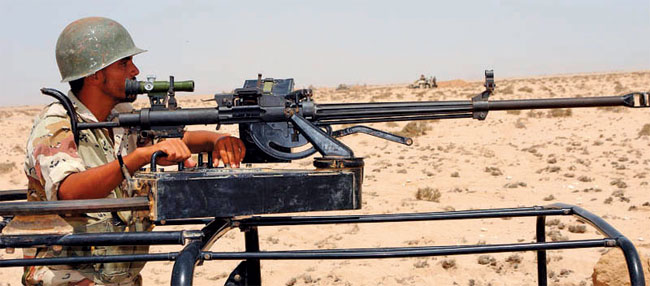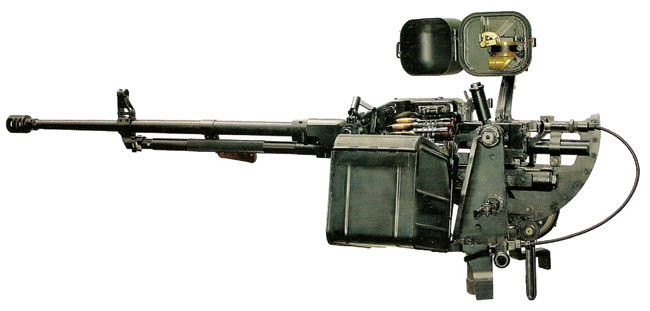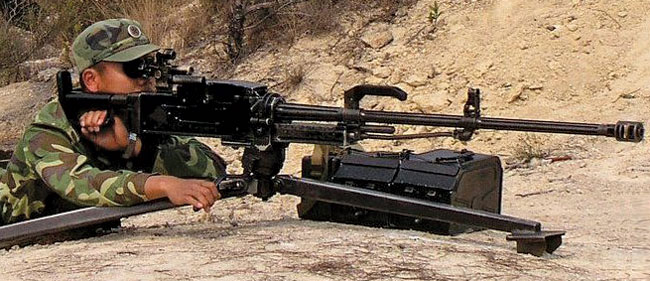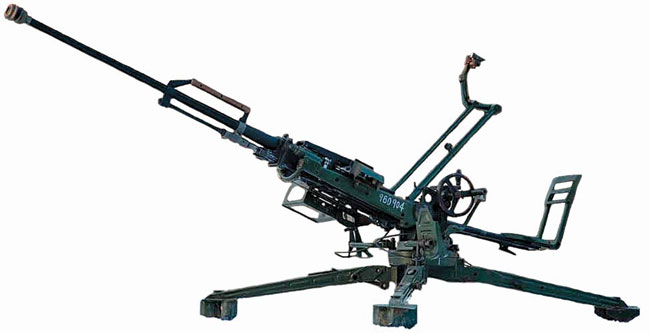ABOVE: Chinese soldiers practicing with 12.7mm W85 HMG.
Up until the 1960s all machine guns manufactured in China were of foreign design. The first heavy machine gun to be produced in China was the 12.7mm Type 54, a straight-up copy of the Soviet DShKM 1938/46, made on Soviet machinery, using Soviet documentation and assistance. This weapon fired the 12.7x108mm round of Soviet origin, which was roughly similar in performance to the American .50 BMG round. Four years later it was joined by its younger but more powerful comrade, the 14.5x114mm Type 58 heavy machine gun. It was another licensed copy of the Soviet weapon, in this case the Vladimirov KPVT. 14.5mm ammunition of Soviet origin brought this weapon to a wholly new level of power delivering 60-80% more muzzle energy compared to contemporary 12.7mm rivals. The latter gun was very useful as a low level anti-aircraft defense weapon, especially when used on specially designed twin and quadruple AA mounts, known as ZPU-2 and ZPU-4, or on lightweight mountain-type single gun ZGU-1 mounts. More than a few of these guns were used during Vietnam War to shoot down numerous U.S. aircraft and helicopters flying at low level. Following political and tactical trends, Chinese designers were then tasked to create more modern replacements for these weapons, starting with the 12.7mm.
During the mid-1970s it was decided to develop a lighter 12.7mm weapon, suitable for mobile AA applications, from ground and vehicle mounts, as well as for ground troop support. The new weapon was officially adopted by the PLA in 1977 as the 12.7mm Type 77 HMG with mass production commencing in 1980. This weapon had a somewhat unusual (for a machine gun) direct impingement gas operated action, apparently in an attempt to save on the weight of the moving parts. Its basic locking system and belt feed were adaptations of the proven Degtyarov DShKM solutions, and the entire gun with a universal tripod weighs some 56 kg (120 lbs) – less than half that of the Type 54 / DShKM on its mount. The Type 77 HMG has a very heavy barrel with a prominent muzzle brake and a slender, tubular receiver. The Type 77 was usually issued with a low-magnification optical sight suitable for both anti-air and ground applications. It seems, however, that this gun left something to be desired as just five years after its entrance into service it was replaced in production by a newer weapon, known as the 12.7mm Type 85 HMG. The Type 85 can be considered as a further evolution of the Type 77 as most of the improvements concentrated at either end of the basic weapon. The “business end” of the new gun received an updated muzzle brake and the dual spade grips and separate cocking handle of the “rear end” were replaced with a sliding trigger unit with horizontal grips of Czechoslovak ancestry. The Type 85, like its predecessor, was also used as a ground and vehicle weapon.
There is another weapon in this line-up, which has no official “Type” designation. Known as W-85, at first glance it looked much like the Type 77 HMG, but closer examination reveals certain differences, such as very thick gas tube below the barrel (which conceals a conventional gas piston, as opposed to piston-less system of the Type 77 and Type 85), and the receiver is of generally rectangular cross-section, while the receivers of the Type 77 and Type 85 are more or less of tubular design. It is believed that the W-85 was built in parallel with the Type 85 HMG, most probably on a competitive basis, but lost in the PLA trials. Apparently, it survived as a commercial venture, as available information suggests that the Norinco Corporation sold for export at least some armored vehicles armed with a “W-85 12.5mm machine gun.” Recently, information has surfaced in Chinese publications about the “new” 12.7mm QJC 88 tank machine gun, which looks exactly like the tank version of W-85.
Still, the PLA was not yet satisfied with the Type 85 HMG, as it was too heavy to be considered as a “high-end” replacement for the 7.62mm GPMGs as used by mobile infantry on foot. Just two years after the adoption of the Type 85 HMG, the PLA adopted an entirely new 12.7mm machine gun, which can be defined as a “lightweight heavy machine gun.” Officially type-classified as the QJZ-89 (12.7mm Type 89 heavy machine gun), this remarkable weapon weighs only 26 kilograms complete with its universal tripod. This is significantly less than the weight of the widely promoted Russian 12.7mm “Kord” machine gun, which weighs 32 kg – on a bipod mount. The only 12.7mm machine gun that weighs less that the QJZ-89 is the U.S.-made XM312, which weighs only 19 kg on its tripod, but, because of its low rate of fire, cannot be effectively used against low-flying targets such as combat helicopters. The remarkable weight reduction of the QJZ-89 is achieved, according to official information, by the use of a combination gas / recoil action. This system is not unique, although it is most often encountered in automatic cannons, where gas action is used to unlock the breech, and recoil can be used to operate the feed, and, more importantly, to decrease the peak recoil forces induced on the firearm housing and the mount. Not much technical information is available on the QJZ-89, and it is yet to prove its worth as a mobile infantry support weapon. According to Chinese sources, the QJZ-89 is capable of using the newly developed 12.7mm APDS ammunition, which increases its performance against lightly armored vehicles.
Up until recently, the most powerful machine gun in the PLA inventory was the 14.5mm Type 58 – a straightforward copy of the Soviet Vladimirov KPV, used on single, twin and quad AA mounts. Only recently has the PLA bothered with a replacement for this old, but still effective weapon, and in 2002 it adopted the new QJG 02 14.5mm HMG. This weapon is of indigenous design, and it looks somewhat like an enlarged W-85. So far it has been observed only on low-profile, single-gun AA mountings, which also can be used for ground applications. However, it seems that Chinese designers decided to go a step further and develop an even more formidable weapon. This resulted in a prototype three-barreled Gatling-type gun firing the 14.5mm ammunition. Externally, this gun looks like a proportionally enlarged GAU-19/A machine gun of American origin, but it is not known if the new 14.5mm weapon is a direct copy of it or not.
Type 77 Heavy Machine Gun
Caliber: 12.7×108
Weight: 28 kg / 62 lbs (gun) + 28.3 kg / 63 lbs (tripod)
Overall length: 2,150 mm / 85 inches
Barrel length: 1,016 mm / 40 inches
Cyclic rate of fire: 650 – 700 rounds per minute
Feed and capacity: Belt, 60 rounds
The Type 77 heavy machine gun is a gas operated, air cooled, belt fed weapon that fires from an open bolt and in automatic mode only. It has a very slim, tubular receiver machined from steel, and uses a direct-impingement gas system with no separate gas piston. The powder gases are fed from the gas block through a three-position gas regulator, which is located at the middle of the barrel, and are then fed through the gas tube to the receiver, where they strike the bolt carrier. The locking system is based on the Degtyarov / Kjellman system, with two pivoting locking flaps located at either side of the bolt.
The barrel is quick-removable; the carrying handle, which is normally attached to the gun at the junction of the receiver and barrel, is used as a barrel lock. To remove the barrel, the carrying handle is rotated counter-clockwise until it can be removed, thus unlocking the barrel; then the carrying handle is attached to the front sight base / gas block and is used to remove the hot barrel from the gun. The front of the barrel is fitted with a large, cylindrical muzzle brake.
The belt feed module is similar to that of the Soviet DShKM system, and is operated through the oscillating arm by the projection on the bolt carrier. Feed is from the left side only. The feed system uses DShK-type belts with open pockets and single-stage, push-through feeding. The belt box can be attached to the weapon to provide better mobility.
Controls include dual spade grips and thumb-triggers; the charging handle is located below the receiver.
The gun is usually issued on a universal tripod, which can be used for both ground and AA missions. This has an adjustable-length front leg, which is retracted for low-profile “anti-ground” use, or extended for AA missions, for which it can be fitted with a special shoulder stock made from steel tubing. The Type 77 is fitted with fully adjustable open sights, plus it has provisions for mounting various telescopic, night vision and special AA sights.
Type 85 Heavy Machine Gun
Caliber: 12.7×108
Weight: 24 kg / 53 lbs (gun) + 17.5 kg / 39 lbs (tripod)
Overall length: 2,150 mm / 85 inches
Barrel length: 1,003 / 39.5 inches
Cyclic rate of fire: 650 – 700 rounds per minute
Feed and capacity: Belt, 60 rounds
The Type 85 heavy machine gun is broadly based on the Type 77, but with certain improvements. It uses the same direct-impingement gas system with flap-locking bolt. The belt feed system is also similar to the Type 77, as well as the barrel change procedure that involves the removal of the carrying handle.
The key difference between the Type 85 and its predecessor is in the arrangement of the trigger and cocking system, which is patterned after the pre-WW2 Czechoslovak ZB 53/vz.37 machine gun. The trigger module of the Type 85 HMG is a separate unit that is attached below the receiver and can slide forward and back. To cock the bolt (as the gun fires from an open bolt) one must release the trigger unit lock, then push the trigger unit forward using the horizontal spade grips, which are attached to the unit. Once the trigger unit is in its forward position, its sear engages the bolt, so retraction of the trigger unit causes the bolt group to unlock and go rearwards. Once the trigger group is fully retracted, it is locked in place by its own lock and holds the bolt in a cocked position until the trigger is released.
The Type 85 HMG is fitted with open sights and has mountings for telescopic, night or special AA sights. It is used from either special vehicle mounts or from a special lightweight infantry tripod. It is also normally fitted with a tubular shoulder stock.
Modifications
W-95: an export version, adapted for .50 BMG/12.7×99 ammunition.
Type 88 (QJC 88) Tank Heavy Machine Gun
Caliber: 12.7×108
Weight: 18.5 kg/41 lbs (gun body)
Overall length: 1,500 mm / 59 inches
Barrel length: n/a
Cyclic rate of fire: 540 – 600 rpm
Feed and capacity: Belt, 50 rounds
The QJC 88 tank machine gun is a gas operated, air cooled, belt-fed, automatic only weapon. Its design is loosely based on the Soviet DShKM heavy machine gun of 1946, although there are many differences in various subsystems.
The QJC 88 uses a long-stroke gas piston, located below the barrel. The piston is rigidly attached to the bolt carrier, which carries a compact breech block (bolt). The locking system can be described as an “inverted” Degtyarov / Kjellman flap lock; it uses two pivoting flaps, one at either side of the bolt, to engage cuts in the receiver walls. The key difference between the QJC 88 and DShKM is that, in the QJC 88, the flaps are pivoted at the rear and have special locking projections that lock into the receiver walls.
The feed is also broadly based on that of the DShKM. The feed module is a detachable unit attached to the top of the receiver. It is operated by a swinging arm that projects down at the right side of the feed. The fork-shaped bottom end of the arm engages a reciprocating charging handle, which is attached to the bolt carrier. Feed is from the left side.
The gun fires from an open bolt, in automatic mode only. The firing pin is operated by a projection on the bolt carrier; the same projection forces the locking lugs outwards so the gun cannot fire unless the bolt is fully locked. A manual trigger is fitted to the rear of the receiver and an electrical solenoid trigger is provided as a part of the tank mounting.
So far the gun has been observed on a roof-top tank mount, with an electrical trigger and a collimating sight installed on the gun cradle.
Modifications
W-85: the original version of the same machine gun, available in either tank or infantry versions. The latter was installed on a universal tripod, and the gun was fitted with dual spade grips and a tubular shoulder stock.
Type 89 (QJZ 89) Heavy Machine Gun
Caliber: 12.7×108
Weight: 17.5 kg/39 lbs (gun body) + 8.5 kg / 19 lbs (tripod)
Overall length: 2,119 mm / 83 inches
Barrel length: 1,003 / 39.5 inches
Cyclic rate of fire: 450 – 600 rpm
Feed and capacity: Belt, 50 rounds
Very little information is available on this machine gun. It is claimed to use combination gas / recoil operated action, with gas system cycling the bolt group and the receiver being allowed to recoil inside the outer gun housing to decrease peak recoil, which must be significant for such a light but powerful gun. The gun uses a direct impingement gas system, apparently borrowed from the Type 77 HMG.
Type 89 HMG uses standard belt feed with belt movement direction being left to right. The barrel is quick-detachable and is fitted with a massive muzzle brake. Standard furniture includes a pistol grip with rifle-type trigger and a tubular shoulder stock. The gun is used from a lightweight tripod of adjustable height, which can be used for both ground and AA applications.
Type 02 (QJG 02) Heavy Machine Gun
Caliber: 14.5×114
Weight: About 75 kg/165 lbs (w/ universal AA mount)
Overall length: n/a
Barrel length: n/a
Cyclic rate of fire: n/a
Feed and capacity: Belt
The Type 02 is a gas operated, air cooled, belt fed machine gun that fires from an open bolt. It uses a rotary bolt locking system.
The Type 02 is associated with a special low profile mount, which consists of an adjustable tripod with a turntable that hosts the gunner’s seat, traverse and elevation mechanisms and the gun cradle with built-in recoil dampers. When traversing, the entire turntable with gunner and gun is rotated; the rotation is controlled by a horizontal wheel located in front of the gunner. Elevation of the gun is controlled by another wheel, located to the left of the traverse control. The gun’s trigger is operated by the pedal. The entire system is said to be easily disassembled into five man-packs, each weighing 20 kg or less.
The Type 02 is typically fitted with a special telescope sight, installed on a parallelogram mount well above the barrel. The sight mount is attached to the gun cradle.
Modifications
QJG 02G: export version with minor changes The tripod can be mounted with two small rubber wheels on two legs, with the third being used as a towing boom for transportation using a jeep-type vehicle.






